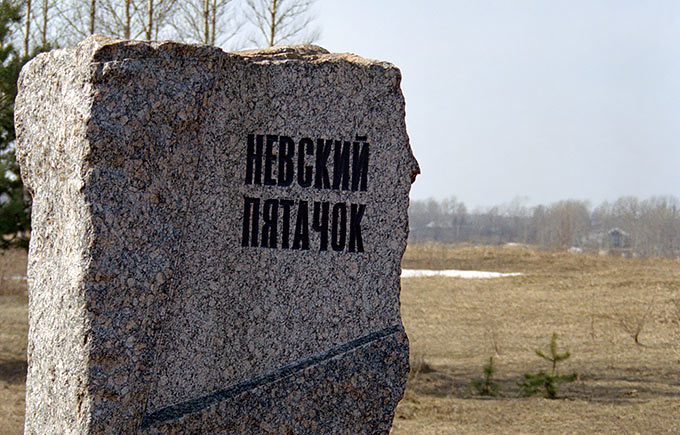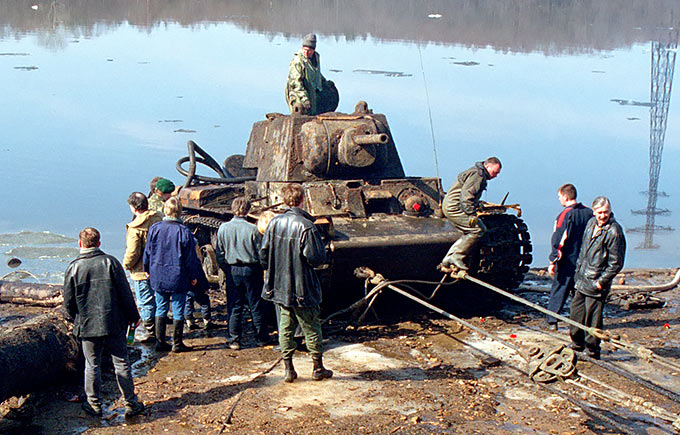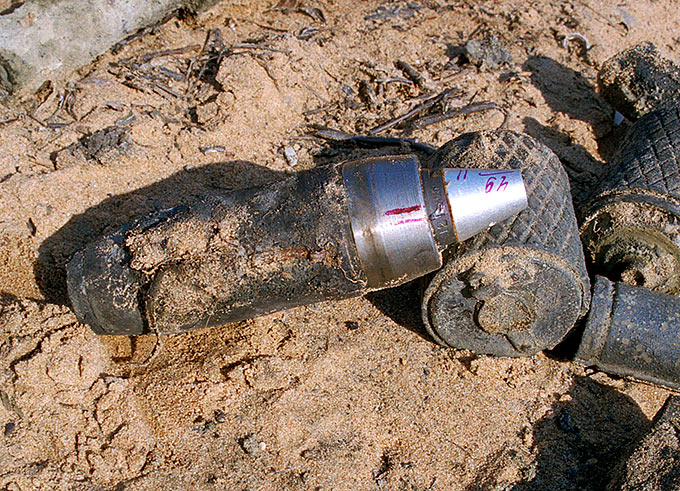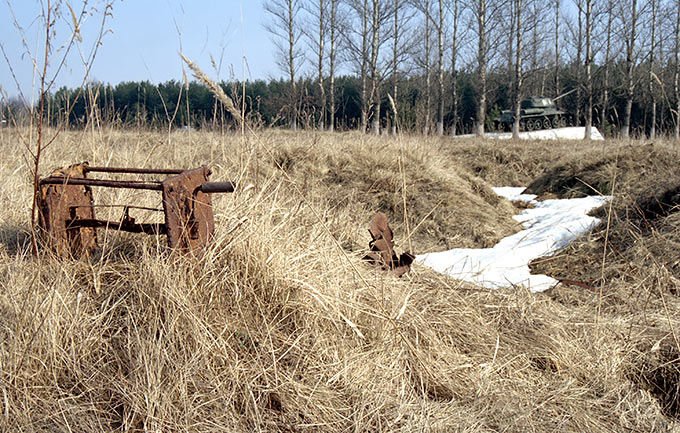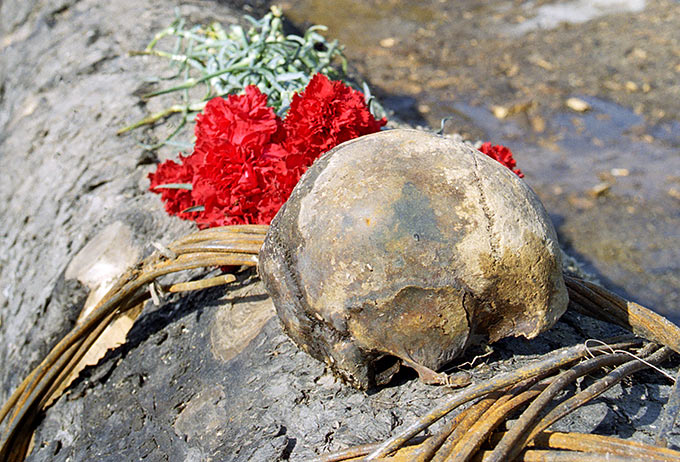There are no walls, moats, bastions or ramparts. It is a common empty plane with remains of old trenches and dry, faded grass. There is the river from the one side and the road and thin forest from the another. There are few war monuments surrounded by high poplars and soldier's cemetery. That is all. But this is the fortress. This is the field of one of the bloodiest battles of World War Two. From 1941 till 1943 there were killed more the 260,000 men on the tiny space with dimensions of 2000 on 800 meters.
It was known also as Nevskij Pjatachok (five-copeck coin) because it's tiny dimensions.
History of Nevskij Pjatachok (Neva's Bridg-Head)
September 8, 1941, Germans seized the town of Schlisselburg. The blockade of Leningrad began. In that day, the German bomber aircraft destroyed the Badaevskie depot of city foodstuff.
12.09.1941 general Zhukov was appointed to the post of commander of Leningrad Front (LF). 18.09.1941 commander of 115th infantry division general Konjkov received the Zhukov's order to cross Neva river, strike to Mga village direction and break the blockade. One brigade of marines was joined for the help. Soviet 54th army of Volkhov Front (VF) should make a strike from opposite direction to Mga. Only two days were given for all preparations.
In the dead of night 20.09.1941 the crossing of Neva began. Firstly one infantry battalion of 576th infantry division crossed the river. One more battalion with 76 mm artillery crossed next morning. After day of hard fight Soviet soldiers took Moskovskaja Dubrovka village, outskirts of Arbuzovo village and cut the road to Leningrad off.
At the same time 46th infantry division made attempts to crossing Neva river to Marjino village and 4th brigade of marines to 8th power-station (8th GRES). The both of attempts were repulsed by Germans with big casualties for Soviet troops. 28.09.1941 10th infantry brigade tried to cross the river in Otradnoe region but was repulsed too.
Severe German counterattacks to the Bridge-head began from the first day of crossing. They began used the tanks from 23.09.1941
The reinforcements of troops and ammunition were sent to the Bridge-head constantly. Another two battalions of marines were put across the river 25 and 28.09, but there was no more advancement to the Mga direction. The first attempt to break the blockade of Leningrad has failed.
On October the NOG (Soviet Nevskaja Operational Group) got the big reinforcements - four infantry divisions, artillery and famous "katjusha" units (jet shell artillery). The second attempt to break the blockade of Leningrad began. 20.10.1941 86th and 285th infantry division were forwarded to the Bridge-head with big casualties. The size of the Bridge-head was enlarged a little. It had dimensions 3000 to 800 meters in that times. But 16.10.1941 Germans began advance to Tichvin and Volkhov and Soviet 54th army could not help with its opposite direction strikes. Soviet attempts to attack from the Bridge-head lasted till the end of October.
German's counter-attacks, bombings and fires did not cease all winter 1941/42. And new reinforcements crossed the river all winter long. However, the Bridge-head was isolated when floating of ice began and April 29, 1942 it's last defenders were killed (330th regiment of 86th infantry division).
26.08.1942 Nevskij Bridge-head was revived. Soviet 76th and 86th infantry division and 11th infantry brigade crossed Neva river after powerful artillery preparation and severe fighting began on the Bridge-head again.
12.01.1943 "Iskra" operation of break of blockade Leningrad began. 45th guards infantry division attacked from the Nevskij Bridge-head to Mga but had very little progress unlike other sectors of offensive. Germans expected the main soviet strike exactly here. Soviet attacks were ceased at the end of the day.
18.01.1943 the town of Schlisselburg was liberated from Germans and blockade of Leningrad was broken. 19.01.1943 fight on Sinjavino heights began. 17.02.1943 Soviet troops blocked and then took 8th power station (8th GRES) by strike from Nevskij Bridge-head. 8th GRES was a strong fortified point of German defense. So, the Bridge-head was merged with the rest of soviet liberated territory.
10.05.1943 Germans tried to restore the blockade of Leningrad by strike from Sinjavino region but unsuccessfully.
22.07.1943 new Soviet assault began. 67th army (LF) attacked from Arbuzovo and Marjino villages in Mga direction. At the same time, 8th army (VF) attacked Mga railway station too. Stubborn fights were lasted till the end of the month. Few heights in Sinjavino ridge and Porechje village were taken by Soviet army in consequence. Soviet advancement was very small, but Germans had considerable casualties.
15.09.1943 Sinjavino heights were liberated at last by 30th guardian infantry corps.
14.01.1944 Soviet operation "Neva-2" began and Germans fell back. Soviet 67th army (LF) and 8th army (VF) started pursuit of enemy. At that moment, the war history of Nevskij Pjatachok (bridge-head) was finished.
Land forts and fortress:
Bip Castle Gatchina Ivangorod Izborsk Kexholm Kirillov Monastery Koporye Novgorod Pechorskiy Monastery Peter&Paul Fortress Porkhov Pskov Schlisselburg Staraya Ladoga Tikhvin Vyborg Hameenlinna Hamina Kastelholm Kymenlinna Lappaenranta Raseborg Castle Savonlinna Tavetti Turku Visby Fredrikstadt Fredriksten Hegra Fort Hoytorp Fort Arensburg Narva Tallinn Antipatris Caesarea Jerusalem Latrun Fort Masada
Sea forts and fortresses:
Alexander Fort Ino Fort Krasnaya Gorka Fort Kronstadt: Kotlin isl. Kronstadt: North Forts Kronstadt: South Forts Trongsund Hanko Svartholm Sveaborg Marstrand Siaro Fort Vaxholm Oscarsborg
Artillery batteries and individual guns:
Coastal Artillery Hemso Fort
Fortified areas and defensive lines:
Karelian Fortified Area (KaUR) KrUR Leningrad Mannerheim Line Nevsky Bridgehead VT Line Harparskog Line Salpa Line Gothland
Russian
S e a r c h All news

